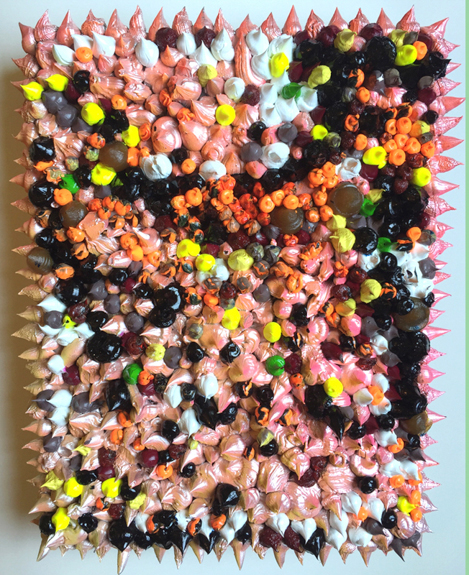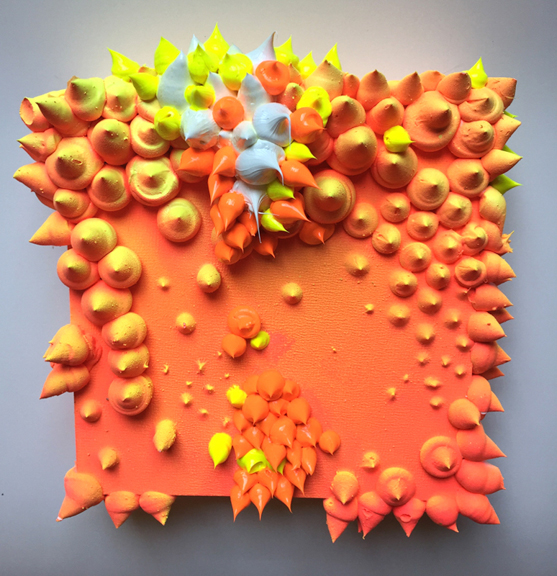Julia Fernandez-Pol
Born in 1984 in St. Louis, MO to Argentine parents, Fernandez-Pol holds a bachelor's degree from Washington University in St. Louis and a master's from Boston University. Her lush abstract paintings can be found in the permanent collections of the Daum Museum and the Colorado Springs Fine Arts Center. Fernandez-Pol is best known for her experimental and responsive approach to process-driven abstract, nature-based creations in oil paint. She typically begins with a strong color field which she builds up in layers of marks, strokes and forms using palette knives, different swaths of colors and pulled paint to create her heavy impasto surface of glossy, flat, thick and thin elements. Growing up in a family of scientists her visual perspective often lends itself to looking through microscopes and telescopes as a child.
While Pursuing the arts she has lived and traveled around the world, NY, Argentina,China, Italy, and Japan. She has attended several prestigious residencies including Yaddo, Oehme Graphics, Riverhouse Editions, and the Vermont Studio Center. She has had 11 solo shows and been included in over 20 group shows around the US, China, and Argentina.
Statement
Nature, like the artist, has an infinite number of ways of expressing itself. My work is driven by interest in creating a world that originates from specific, dynamic forms found universally in nature.
I am fascinated with creating experiences of extreme beauty and visual decadence in order to generate an overwhelming visual impact within our contemporary world. I use excess and opulence to explore the human experiences when confronted with truly unusual and incredible growths, patterns, and structures in the natural world. I create abstract landscapes of microscopic and macroscopic scale that are developed organically based on ideas of circularity, regeneration, accumulation, and decay.
Q&A with Julia Fernandez-Pol
by Lydia O'Reilly
Can you give us some insight into your art-making process? Do you plan out your designs before you execute them, or is it more of an intuitive process?
My process is driven by a combination of experimentation and playful intuition with color and materials. My work is really about capturing that process and allowing the viewer to travel through that process.
Iʼm interested in organic randomness and chaos through mathematical structures. That being said I have never been the kind of artist who can plan a painting or drawing out. There is an underlying drawing that presents itself during the process. Sometimes itʼs very clear early on and sometimes it takes longer and has to develop through generative mark making. Inherently some paintings become much more about color accumulation and others about the suspended organic actions and materials.
Your work shows a careful placement of paint and intensive layering. How do you decide what goes on the canvas next? Is there room for mistakes?
Mistakes are always welcome, itʼs important for me to seek them out, they change the rules I may have set up, forcing me to think differently. Maybe at the same time I donʼt ever think of them as mistakes but a set up for something new to happen. More than anything I think the mistakes are about being open to that unknown creating challenges and discovering new relationships.
At first, I thought the paintings in your "Elements" series were MIG-welded designs, not paint! Is this paint squeezed directly out of the tube? When did you arrive at the idea to use such heavy impasto?
Iʼve always been a little excessive in my use of paint. I think I used to be a little shy, doubtful and judgmental about it. During my time at Washington University in St. Louis, was when I first started using syringes to apply paint in more sculptural ways and that continued through grad school at Boston University. The paint acted more like bacterial growth on the paintings back then. These newer smaller paintings Iʼve been working on, carry a different meaning through the scale. My interest in science and materials has changed and developed throughout the years.
I have to ask—how long does it take one of your paintings to dry? That much oil paint much be a pain to dry and finish.
Itʼs a miserably long drying time. Some of the first square paintings I did had been sitting under a table for at least a year and were not even close to dry. I typically use
mediums and resins which speed up the dry time and also add to variety of finishes. Iʼm actually quite impatient and struggle with dry times. The more recent ʻsurfaceʼ paintings have pushed me to reconsider my materials and Iʼm very excited about the direction of these paintings. Iʼm able to use acrylic or even casting them as objects using resin or metal.
You have described your work as a study in "visual decadence," and your work is certainly a feast for the eyes. Sadly, I have only ever had the opportunity to look at photographs of your work. What are we missing from your work in person that we cannot experience from a photo?
While these newer paintings photograph well, I know the urge is to reach out and touch them before making any verbal sense out of them. They are very tactile and the nature of photography is flat. Iʼm looking to elicit the urge to touch them, that visceral reaction. In the larger paintings itʼs really a different experience about traveling through the process and getting lost in them. That sense of escapism is important for me in the work especially the larger scale paintings to create that experience of being enveloped by them.
Would you consider yourself a colorist or a formalist? Historically, there has been a separation (even antagonism) between these two artistic approaches, but you seem to unite them with your sculptural handling of pure paint color. Do you think the art world needs a new set of parameters to talk about art today?
I donʼt feel compelled to be one or the other, both factor into my work while color may play the more obvious role. I think the parameters are always changing but it takes time.
Are there any artists (past or present) that you consider yourself to be in dialogue with?
Iʼve always been influenced by Picasso, Francis Bacon, Joan Mitchell, Philip Guston, and Eva Hesse to name a few.
You describe your paintings as "abstract landscapes that explore both the microscopic and the macroscopic." Do you see the microscopic and the macroscopic to be one and the same? I am reminded of a quote by Victor Hugo in Les Miserables: "Where the telescope ends, the microscope begins. Which of the two has the grander view?"
Yes, exactly! Both exist in one another depending on your perspective, and thereʼs an idea of infinity to that. This is another aspect of circularity that plays into my work. On another level Iʼm interested in the science behind optics which is becoming more the focus of my work.
Many of your drawings and sculptures (not featured in Maake, but readers should check out your website to see them!) are reminiscent of botanical illustrations (Insects and Eyeballs, etc.) or biological specimens in glass cases ("Naturaleza Enjaulada" series). When did you become interested in the intersections between art and science? Do you think that art and science are unfairly separated in academia?
I grew up in a household immersed in science, we looked at all sorts of things under microscopes, dissected things, pulled out the telescope to look at Jupiterʼs rings it was a lot of very unique experiences. My dad was a research scientist and as a family we all developed our own inclinations towards science. My dad passed that curiosity in nature and science to me at a very young age, and that became my visual language. Iʼve always gravitated towards, the intersection between science, art and beauty.
In your "Emissions" series, your pieces have titles like Radioactive, Scorched, and Sub-atomic. The words seem to reference environmental havoc or science gone awry. Is this related to your stated themes of "excess and opulence"? Is there beauty in destruction?
The emission series is related to the environmental issues: dynamic changing systems and extremes of chaos and volatility in nature. Ideas of opulence and excess while related to beauty in nature are more inclined towards a social construct and human behavior. While they relate in many ways, I tend to compartmentalize them in my work. When they start to intersect and integrate in larger scale work I think it will lead to interesting moments and get to the root of these ideas.
I think itʼs impossible to understand one thing, beauty, without the opposite which we can call destruction or decay. There is that circularity again.
Thanks so much for sharing you work and talking with us!
To find out more about Julia's work, check out the artist's website.










